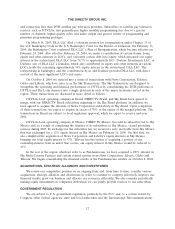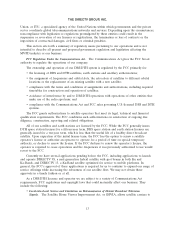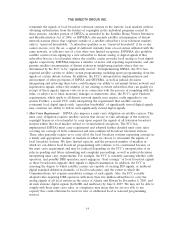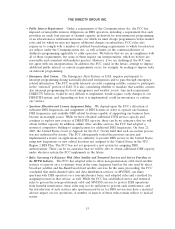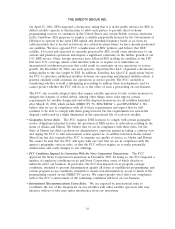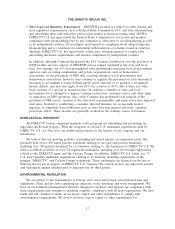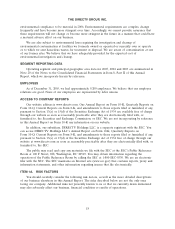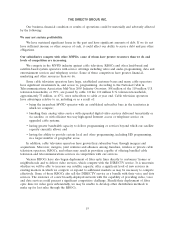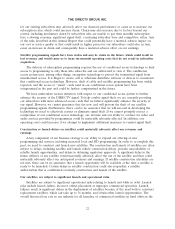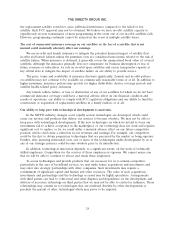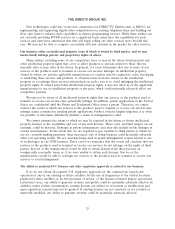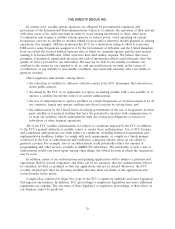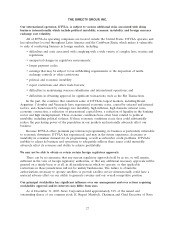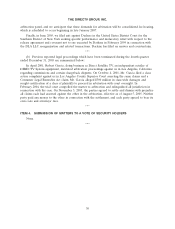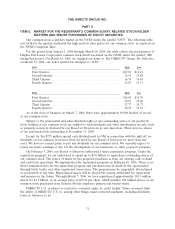DIRECTV 2005 Annual Report Download - page 34
Download and view the complete annual report
Please find page 34 of the 2005 DIRECTV annual report below. You can navigate through the pages in the report by either clicking on the pages listed below, or by using the keyword search tool below to find specific information within the annual report.THE DIRECTV GROUP, INC.
requirements. DIRECTV U.S may not be able to comply with these must carry rules, or compliance
may mean that it is not be able to use capacity that could otherwise be used for new or additional local
or national programming services.
Our subsidiaries depend on others to produce programming and programming costs are increasing.
We depend on third parties to provide us with programming services, including third parties who
are our affiliates and third parties controlled by competitors. Our ability to compete successfully will
depend on our ability to continue to obtain desirable programming and deliver it to our subscribers at
competitive prices. Our programming agreements generally have remaining terms ranging from less
than one to up to ten years and contain various renewal and cancellation provisions. We may not be
able to renew these agreements on favorable terms, or at all, or these agreements may be cancelled
prior to expiration of their original terms. If we are unable to renew any of these agreements or the
other parties cancel the agreements, we may not be able to obtain substitute programming, or if we are
able to obtain such substitute programming, it may not be comparable in quality or cost to our existing
programming.
In addition, many of our programming agreements contain annual price increases. When offering
new programming, or upon expiration of existing contracts, programming suppliers have historically
increased the rates they charge us for programming, increasing our costs. We expect this practice to
continue. Increases in programming costs could cause us to increase the rates that we charge our
subscribers, which could in turn cause subscribers to terminate their subscriptions or potential new
subscribers to refrain from subscribing to our service. Furthermore, we may be unable to pass
programming cost increases on to our subscribers, which could have a material adverse effect on our
earnings or cash flow.
The FCC recently adopted rules requiring us to negotiate in good faith with broadcast stations
seeking carriage outside of the mandatory carriage regime described above. The rules for
‘‘retransmission consent’’ negotiations, which are similar to those that have applied to broadcast
stations for years, require us to comply with certain indicia of good faith negotiation, as well as to
demonstrate good faith under a ‘‘totality of the circumstances’’ test. Failure to comply with these rules
could subject us to administrative sanctions and other penalties.
Our subscriber acquisition costs could materially increase.
We incur costs relating to subscribers acquired by us and subscribers acquired through third-
parties. These costs are known as subscriber acquisition costs. For instance, we provide installation
incentives to our retailers to enable them to offer standard professional installation as part of the
subscriber’s purchase or lease of a DIRECTV System. In addition, we pay commissions to retailers for
their efforts in offering a DIRECTV System to consumers. Our subscriber acquisition costs may
materially increase to the extent we continue or expand current sales promotion activities or introduce
other more aggressive promotions, or due to increased competition. Any material increase in subscriber
acquisition costs from current levels would negatively impact our earnings and could materially
adversely affect our financial performance.
Increased subscriber churn or subscriber upgrade and retention costs could materially adversely affect
our financial performance.
Turnover of subscribers in the form of subscriber service cancellations, or churn, has a significant
financial impact on the results of operations of any subscription television provider, including us, as
does the cost of upgrading and retaining subscribers. Any increase in our upgrade and retention costs
21



